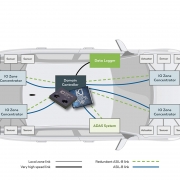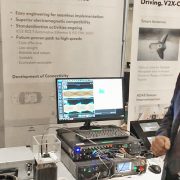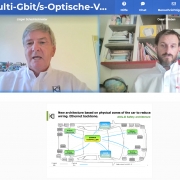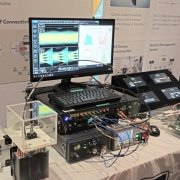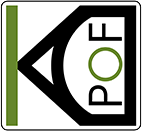The KDPOF team is proud to have been selected as one of 40 startups for High-tech Venture Days (HTVD). HTVD is a platform and annual program for startups, investors and corporates. The aim is to foster innovation made in Europe by providing access to capital for high-tech startups that deliver patent-based technologies for B2B applications. This year’s event will take place from 26 to 27 October 2021, in Dresden, Germany, and online from 28 to 29 October 2021.
Together with several industry leaders, KDPOF is working on an optical automotive multi-gigabit system that will fulfill the needs of future connected and automated vehicles. Instead of various port components, the new solution provides a single, complete package. “As the auto industry approaches the 50 Gb/s*m speed-length threshold, the move from copper to optical physical data transmission media is becoming mandatory,” stated Carlos Pardo, CEO and Co-founder of KDPOF. “Optical is the engineering-wise path for higher data rates.” The new connector systems are very small, lightweight and extremely inexpensive compared to the previous ones. With the comprehensive EVK9351AUT evaluation kit, automotive manufacturers and suppliers can already test the new configuration at 1 Gbit/s today. KDPOF thus supports easy project entry into optical gigabit connectivity for a secure Ethernet backbone and ADAS sensor connections in vehicles. Read more
From September 29 to October 1, 2021, KDPOF will display an update on optical gigabit networking in vehicles at the virtual SIAT – Symposium on International Automotive Technology 2021. Cars are not solely about driving anymore – electronic devices such as anti-collision cameras, DVD players, and navigation systems make the difference. Like infotainment systems, Automotive Driver Assistance Systems (ADAS) are becoming an integral part of the vehicle, with interfaces to many different clusters of electric/electronic systems. Read more
At the virtual Wire Harness Congress on September 22, 2021, KDPOF will inform about the status of Optical Multi-gigabit Connectivity in vehicles. In their presentation at 11:45, Juergen Schachtschneider, Automotive Manager Central Europe & Greater China, and César Esteban, Applications & Support Manager, will propose a complete optical communications system, which is under development by KDPOF and their industry partners. Read more
On August 13, 2021 from 11:00 a.m. to 12:30 p.m. IST (Indian Standard Time, 6:00 to 7:30 a.m. UTC), Óscar Ciordia, César Esteban, and Kenny Yoon will give the online seminar “The Use of Plastic Optical Fiber in the Automotive Industry”. The seminar is organized by the Society of Automotive Engineers India (SAE India). Read more
Carlos Pardo will give an online presentation about Automotive Optical Multi-gigabit Ethernet at the Automotive Technologies Virtual Conference on May 13, 2021 at 5:30 p.m. EST and on demand. In-Vehicle Network (IVN) requirements are quickly evolving with new challenges like automated driving or electric power trains. The IVN has to support use cases such the vehicle data backbone, smart antennas, ADAS cameras/sensors, and displays or data loggers which demand higher data bandwidth while maintaining the reliability level required by the automotive industry. A new IVN standard is needed for multi-gigabit optical communications.
This optical automotive IVN communication standard, 802.3cz, is currently under development within the IEEE and is supported by several industry-leading companies. The new standard will cover rates up to 50 Gbits/s and support several in-line connectors. The target BER is better than 10-12 with ambient operation temp from -40°C up to +105°C (AEC-Q100 grade 2) in harsh automotive environments. High reliability (15 years operation, less than 10 FIT), and outstanding EMC compliance will also be fulfilled. In his presentation, Carlos Pardo will cover the needed standard, and detail the components needed to make this a reality.
For more information and registration, please visit automotivevirtualconference.com
KDPOF has successfully participated at the virtual ISCAS 2020 in October with several contributions: a presentation on multi-gigabit Ethernet for the automotive industry, an overview lecture on high-speed data communications over POF, and an important role in the final industry panel session. The IEEE International Symposium on Circuits and Systems (ISCAS) is the flagship conference of the IEEE Circuits and Systems (CAS) Society and the world’s premiere networking forum for researchers in the highly active fields of theory, design, and implementation of circuits and systems.
Towards the Multi-Gigabit Ethernet for the Automotive Industry
Session Chairmen Enrique Prefasi Sen, Analog and Mixed Signal Senior Designer of KDPOF, and Alberto Rodríguez-Pérez, Analog and Mixed Signal Manager of KDPOF, have presented the paper “Towards the Multi-Gigabit Ethernet for the Automotive Industry”. The paper, within the special session “Multi-gigabit Wireline & Optical Communication Circuits & Systems Session”, showed the status of Ethernet-based communication solutions, focused on optical links for the automotive industry. They displayed the implementation of a product compatible with the 1000BASE-RHC according to the IEEE Std 802.3bv, which is the first one able to transmit 1 Gbps over POF for automotive. In addition, the KDPOF experts described a new architecture to achieve up to 25 Gbps for automotive. The proposed multi-gigabit system leverages existing technologies such as VCSELs, multi-mode fibers, and photodiodes already developed for the data center industry.
High-Speed Data Communications over Fiber Optics
In his lecture, Alberto Rodríguez-Pérez gave an overview of the use of Plastic Optical Fiber as a medium for optical data communications and the techniques needed to get high speed data bitrates over POF. It is an interesting alternative optical communication channel to the Glass Optical Fibers (GOF) for applications that are not required to cover long distances, such as home or automotive networking. However, the reduced low bandwidth of the POF channel imposes big limitations in the maximum data bitrate that can be transmitted through this medium. Consequently, advanced data communication techniques such as channel equalization, data error correction, or data signal modulation need to be applied to achieve data bitrates above 1 Gbps.
Please see here for the video explaining the Multi-Gigabit demo.

By loading the video, you agree to YouTube's privacy policy.
Learn more
Optical network technology overcomes these trends thanks to its inherent galvanic isolation, robustness, low cost, and low weight. Carmakers will benefit from optical links for communications between the 48-volt and the 12-volt domains. For weight, the optical network will save more than 30 percent of the equivalent copper-based harness weight. Optical Ethernet provides 100 Mb/s and 1 Gb/s network solutions today, and multi-gigabit Ethernet is the significant upcoming breakthrough for in-vehicle networks. The standardization effort for optical multi-gigabit is already in progress within the IEEE as an amendment to the Ethernet standard 802.3.
KDPOF is delighted to present at the virtual Photonics Days Berlin Brandenburg 2020 from October 5 to 8, 2020. On Monday, October 5 at 10:40, César Esteban, Application and Support Manager of KDPOF, will give the presentation “Optical Automotive Ethernet” within the session “Innovative Optical Fibers”. Plastic optical fibers (POF) are the most reliable solution in vehicles since they can withstand harsh environments, vibrations, misalignments, dirtiness, humidity, wide temperature range, etc. Additionally, optical Ethernet generates very low noise and can operate in noisy environments, such as in RF electronic boards.
Full Standardization of Optical Gigabit
Recently, ISO (International Organization for Standardization) has added two new sections to the in-vehicle Ethernet series 21111. These newly approved parts are key components to assure reliable implementations of systems that realize in-vehicle Ethernet Optical 1 Gb/s as a physical layer. With the new ISO 21111 sections complementing the existing IEEE Std 802.3bvTM, optical Gigabit connectivity is now entirely standardized. Based on these standards, KDPOF’s optical technology allows a complete, compatible, and interoperating implementation for carmakers and Tier1s.
The KD1053 transceiver perfectly meets the requirements of carmakers by providing high connectivity with a flexible digital host interface, low latency, low jitter, and low linking time. The transceiver is optimized for low power and small footprint and transmits data at 1000/100 Mb/s on standard SI-POF, MC-POF, or PCS, according to 1000BASE-RH (IEEE 802.3bv).
Outlook on Optical Multi-Gigabit
With technological leaps such as electrical vehicles, automated driving, and V2X interconnection rushing through, automotive applications, utilization, and safety requirements are boosting the necessary network speed tremendously. Consequently, in-vehicle networks are on the brink of speeds from one to multiple gigabits per second. Optical Multi-Gigabit Ethernet in the car is on the verge of standardization and implementation. With the approval of the IEEE 802.3 working group, a team of individuals affiliated with more than 15 key carmakers and components suppliers, including KDPOF, has started the standardization of an IEEE 802.3 Automotive Optical Multi-Gigabit Standard with strong support from the industry. KDPOF has already displayed the world’s first demonstration of an automotive-grade optical transmission system with 50 gigabits per second single lane, leveraging datacom components.
KDPOF is looking forward to participating in the upcoming virtual ISCAS 2020 from October 10 to 21 with several contributions: a presentation on multi-gigabit Ethernet for the automotive industry, an overview lecture on high-speed data communications over POF, and an important role in the final industry panel session. The IEEE International Symposium on Circuits and Systems (ISCAS) is the flagship conference of the IEEE Circuits and Systems (CAS) Society and the world’s premiere networking forum for researchers in the highly active fields of theory, design, and implementation of circuits and systems.
Presentation: Towards the Multi-Gigabit Ethernet for the Automotive Industry
On Tuesday, October 13, 2020, from 17:15 to 18:55, session Chairmen Enrique Prefasi Sen, Analog and Mixed Signal Senior Designer of KDPOF, and Alberto Rodríguez-Pérez, Analog and Mixed Signal Manager of KDPOF, will present the paper “Towards the Multi-Gigabit Ethernet for the Automotive Industry”. The paper, within the special session “Multi-gigabit Wireline & Optical Communication Circuits & Systems Session”, will show the status of Ethernet-based communication solutions, focused on optical links for the automotive industry. First, the presenters will display the implementation of a product compatible with the 1000BASE-RHC according to the IEEE Std 802.3bv, which is the first one able to transmit 1 Gbps over POF for automotive. Second, the KDPOF experts will describe a new architecture to achieve up to 25 Gbps for automotive. The proposed multi-gigabit system leverages existing technologies such as VCSELs, multi-mode fibers, and photodiodes already developed for the data center industry.
Lecture: High-Speed Data Communications over Plastic Optical Fibers
Alberto Rodríguez-Pérez will give an overview lecture on Saturday, October 17, 2020, from 16:00 to 16:45 in virtual room 2. In his lecture, Alberto will show an overview of the use of Plastic Optical Fiber as a medium for optical data communications and the techniques needed to get high speed data bitrates over POF. It is an interesting alternative optical communication channel to the Glass Optical Fibers (GOF) for applications that are not required to cover long distances, such as home or automotive networking. However, the reduced low bandwidth of the POF channel imposes big limitations in the maximum data bitrate that can be transmitted through this medium. Consequently, advanced data communication techniques such as channel equalization, data error correction, or data signal modulation need to be applied to achieve data bitrates above 1 Gbps.
Industry Panel
KDPOF is also substantially involved in the final Industrial Panel Discussion on Wednesday, October 21, 2020, from 16:45 to 17:45. Alberto Rodríguez-Pérez will chair the panel and Rubén Pérez de Aranda, CTO of KDPOF, will participate as panelist.
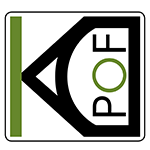

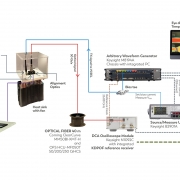

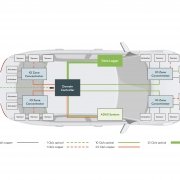 KDPOF
KDPOF